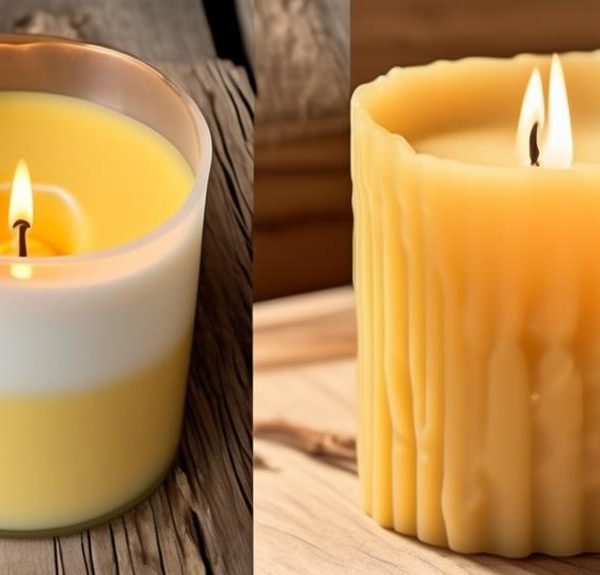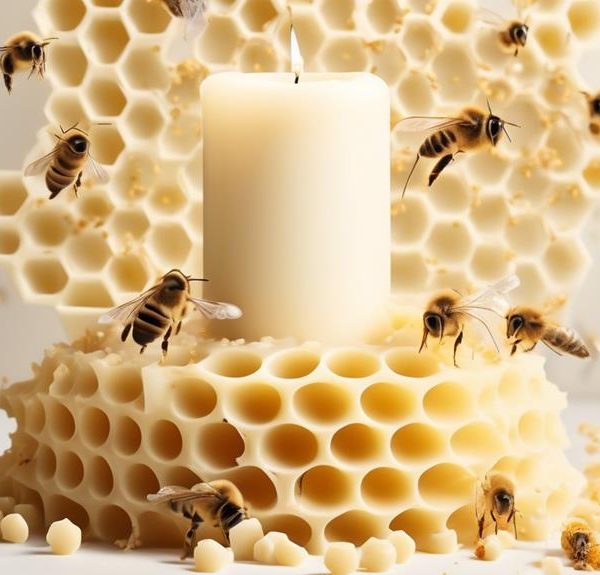Surviving indoors, a bee's lifespan hinges on multiple factors; explore the unexpected intricacies of their indoor longevity.
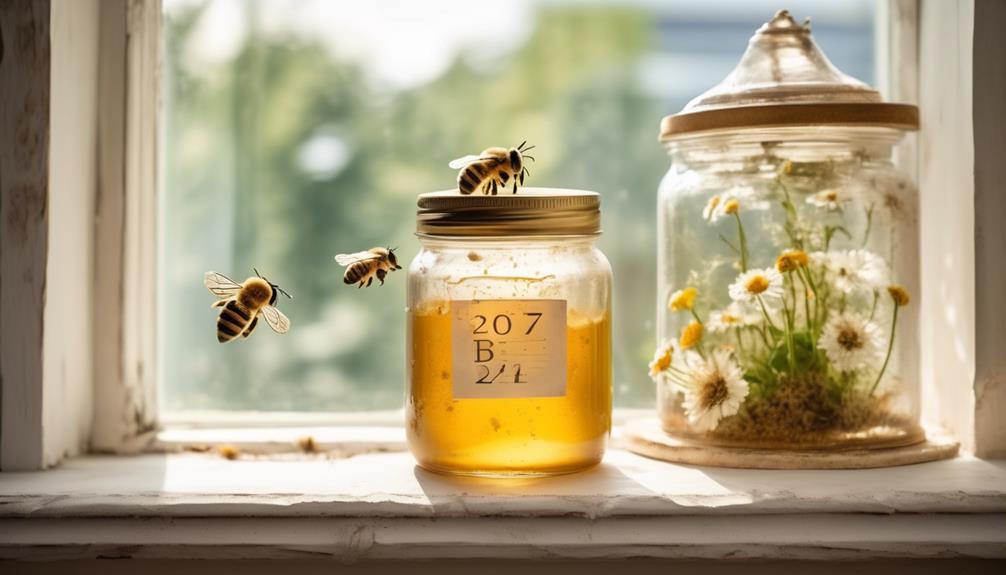
How Long Do Bees Last Indoors?
Well, you've finally done it. You've managed to invite a bee into your living room, and now you're pondering the lifespan of your uninvited guest.
It's a strange question, isn't it? But it's not an insignificant one. The longevity of bees indoors depends on a variety of factors such as the type of bee, availability of food, temperature, and even the bee's own stress levels.
But don't worry, we're not leaving you to figure this out on your own. Let's explore how long your buzzing companion might last inside, and why it might not be as long as you'd think…
Key Takeaways
- The lifespan of bees varies depending on their species, role, and environment.
- Bees' indoor survival is influenced by factors such as lack of suitable food sources, inability to forage and mate, and temperature and humidity levels.
- Bees exhibit altered behaviors when indoors, such as mistaking windows and lights for the sun and flying towards light sources in an attempt to escape.
- Mitigating risks for indoor bees can involve calmly guiding them towards a window or door, providing sugar water for dehydration or starvation, and contacting professionals for removal.
Understanding Bee Lifespan

To fully grasp the longevity of bees indoors, it's crucial to first understand the typical lifespan of these fascinating insects. Bees' lifespans vary significantly, dependent on their species, role, and environment.
Worker bees, which are all female, live for roughly five to six weeks during the summer months. They're the most populous in a colony and their short lives are often due to their tireless work collecting pollen and nectar.
On the other hand, male drone bees live a bit longer, about eight weeks. Their primary role is to mate with the queen, after which they'll perish.
Now, the queen bee is the real anomaly. She can live for several years, with a lifespan ranging from two to five years. Her longevity isn't just down to her royal status, but it's also due to her diet of royal jelly, a protein-rich secretion from worker bees.
When bees are trapped indoors, their lifespan can be drastically reduced. This reduction is due to a lack of food, inability to forage, and unsuitable living conditions. Thus, understanding bee lifespan is vital to comprehending their survival indoors.
Factors Influencing Indoor Survival

Several factors can significantly influence a bee's survival indoors. Lack of suitable food sources and the inability to perform crucial behaviors like foraging and mating are among these factors. Bees need pollen and nectar for sustenance. When trapped indoors, they are cut off from these essentials, leading to starvation. Without a diverse diet, their immune systems weaken, leaving them more susceptible to diseases.
The temperature and humidity levels indoors can also affect their survival. Bees are ectothermic, meaning they depend on environmental heat sources. If your home is too cold, they cannot maintain their body temperature. Conversely, if it is too dry, it could lead to dehydration.
Additionally, bees are social insects that live in colonies. Isolation can stress them out, disrupting their natural behaviors and lifespan. They communicate, reproduce, and work together in a hive. When confined indoors, they cannot perform these functions, which can lead to premature death.
Bees' Indoor Behavior
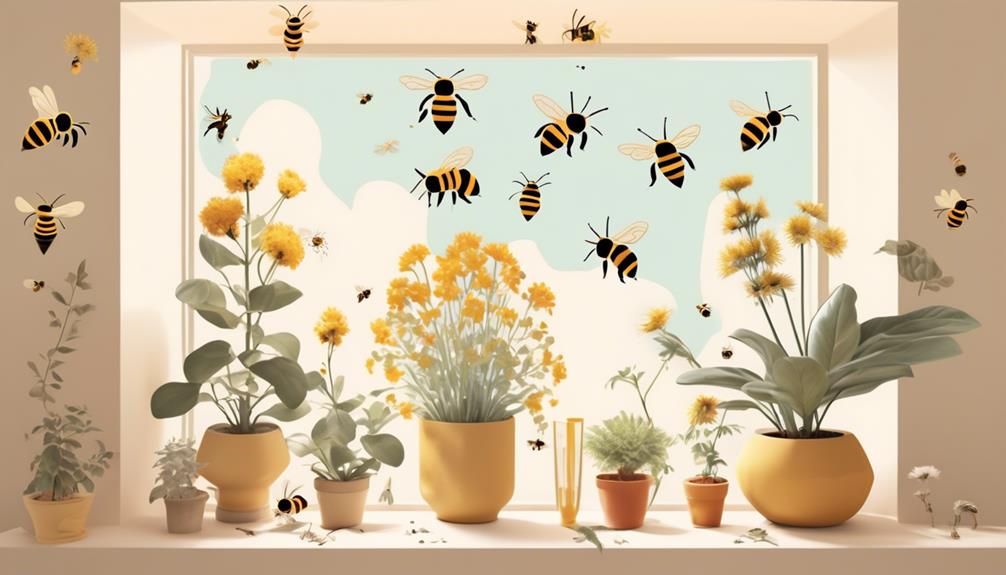
Understanding how these factors impact a bee's lifespan indoors, it's equally crucial to observe their behavior in this unusual environment. Inside, bees exhibit altered behaviors compared to their outdoor counterparts. They typically appear disoriented and stressed, often buzzing around windows and lights, which they mistake for the sun.
In an attempt to escape, you'll notice these insects flying towards light sources, including artificial ones, as they instinctively navigate by the sun. They're likely to hit against windows repeatedly, causing potential physical damage or exhaustion, which can shorten their lifespan.
Furthermore, bees are social insects. In their hives, they exhibit complex behavioral patterns, like division of labor, communication through 'waggle dances,' and cooperative brood care. Isolated indoors, they're unable to perform these activities that are essential for their well-being and survival.
Indoor bees also lack access to food sources. They rely on nectar and pollen from flowers for nutrition. Without it, they'll starve, significantly impacting their lifespan. Though they might get attracted to sweet substances indoors, these don't offer the balanced diet they need.
It's clear that an indoor environment poses numerous challenges to a bee's survival, primarily due to behavioral changes and lack of resources.
Mitigating Risks for Indoor Bees
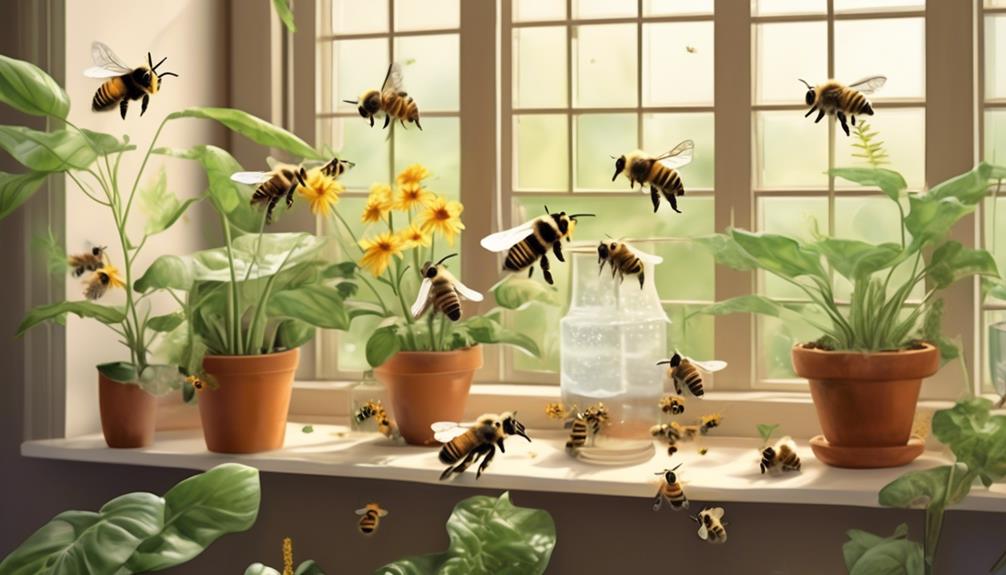
While it's not ideal for bees to be trapped indoors, you can mitigate the risks and potential harm to these insects by implementing some simple strategies.
Firstly, try to avoid panic or aggressive movements, as these can startle the bee and provoke an attack. Instead, calmly guide the bee towards a window or door using a piece of paper or cardboard.
Secondly, if the bee seems lethargic, it may be due to dehydration or starvation. You can help by providing a small amount of sugar water on a spoon or plate. However, don't let the bee get too wet as this can cause its wings to stick together, making flight difficult.
If the bee remains indoors for a prolonged period, its survival chances decrease. Bees aren't evolved to live indoors and lack the necessary resources for survival, such as nectar and pollen. In such circumstances, you should consider contacting a local beekeeper or pest control service to safely remove the bee.
The Role of Human Intervention
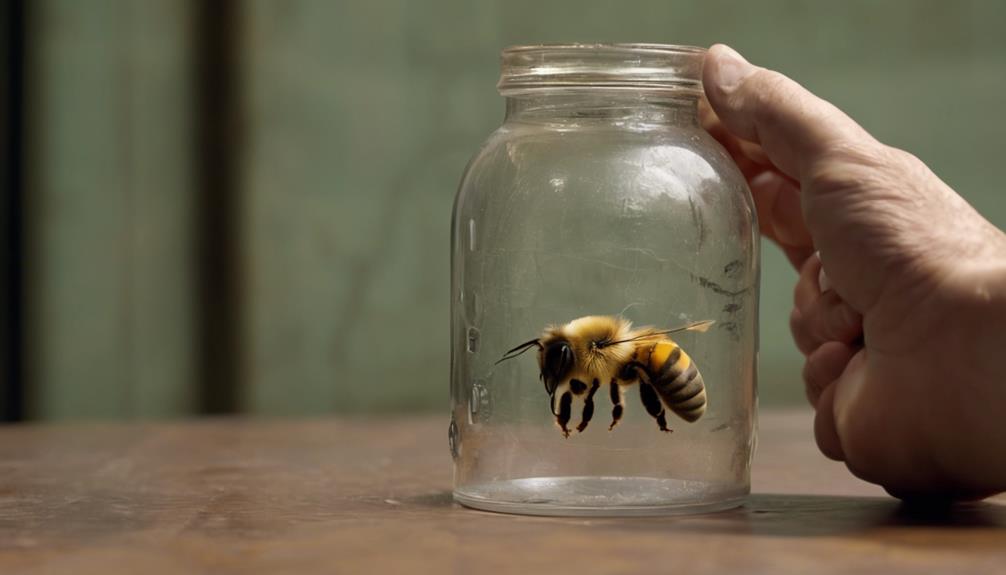
Although mitigating risks for bees trapped indoors is crucial, it's also important to recognize the significant role humans play in determining their fate. You've the power to either prolong or shorten a bee's lifespan once it enters your home.
Your actions can have a profound impact on the bee's survival odds. Bees, like other insects, require specific environmental conditions to thrive. Certain actions, such as adjusting the room temperature or humidity levels, can alter the indoor conditions and stress the bees, potentially reducing their lifespan.
Furthermore, the provision of food and water sources can greatly increase a bee's survival rate. Bees primarily consume nectar and pollen, and while you can't exactly provide them with flowers indoors, a simple sugar water solution can suffice in the short term.
However, the most humane and effective intervention you can make is to safely guide the bee back outdoors. Bees are pollinators and play a vital role in our ecosystem. They're not designed to live indoors. Therefore, helping them return to their natural habitat is the best course of action. This not only benefits the bee, but also contributes positively to our environment.
Frequently Asked Questions
What Types of Bees Are Most Likely to Enter Homes?"
You're most likely to encounter honeybees and bumblebees entering your home. Honeybees are attracted to sweet scents and might come in through open windows.
Bumblebees often look for nesting sites and can find small openings into houses appealing. However, it's important to remember, they're not there to cause harm, they're just looking for shelter or food.
It's best to safely remove them without killing, as they play a vital role in our ecosystem.
How Do Bees Impact Indoor Air Quality?"
Bees don't typically impact indoor air quality. They're not known to release any harmful substances into the air. However, if you're allergic to bees, the presence of one can trigger an allergic reaction.
Also, if a bee dies indoors, it can attract pests that might affect your air quality. So, it's best to usher any bees outside as soon as you spot them.
They're vital for the environment, but they're not suited for indoor living.
What Are Some Common Signs That Bees Are Living Inside Your House?"
You'll likely hear buzzing sounds in your walls or attic, often louder at dawn and dusk.
You might spot bees entering and exiting a hole in your home's structure.
Dark stains on walls or ceilings can indicate bee waste.
An increase in dead bees inside your home is another telltale sign.
Lastly, you could notice a sweet, honey-like smell, which suggests a hive.
Always contact a professional if you suspect a bee infestation.
How Do You Safely Remove Bees From Your Home Without Killing Them?"
To safely remove bees from your home without killing them, you'll need professional help. Contact a local beekeeper or a pest control service specializing in humane bee removal. They'll typically use smoke or a bee vacuum to calm the bees and gather them.
Avoid DIY methods involving pesticides, as they're often harmful to bees and other beneficial insects. It's crucial to remove the entire colony, including the queen, to prevent re-infestation.
What Precautions Should Be Taken to Prevent Bees From Entering Your Home?"
You should ensure all windows and doors are properly sealed.
It's important to check for cracks or holes in your home's exterior where bees could potentially enter.
Regularly inspect your property for signs of a hive and remove any potential food sources.
If you have a garden, try to plant flowers that don't attract bees.
Always consult a professional if you're dealing with a bee infestation.
Conclusion
In conclusion, bees can survive a few hours to several days indoors, influenced by factors like temperature, food availability, and stress levels. They may act erratically due to lack of natural stimuli. Ensuring a safe exit can help them return to their natural habitat.
Human intervention, while often well-intentioned, can inadvertently cause harm. Understanding bees' needs and behavior indoors is crucial to minimizing risks and promoting their survival.

